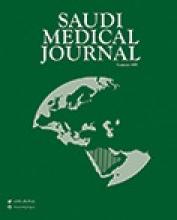Abstract
OBJECTIVE: Dehydroepiandrosterone (DHEA) and DHEA-sulfate (DHEA-S) are the most abundant steroids in human plasma. Previous studies have shown that administration of DHEA-S is more effective than DHEA in reducing adipose tissue mass and cellularity in rats. Another study suggested that maintaining high levels of DHEA-S might prevent the development of obesity. Therefore, this study aims to determine the relationship of plasma dehydroepiandrosterone sulfate (DHEA-S) levels with respect to obesity, fasting insulin and glucose levels in a cohort of obese and normal weight healthy Saudi women.
METHODS: This study was carried out at King Abdul-Aziz University Hospital, Jeddah, Kingdom of Saudi Arabia during the year 2001. A total of 65 healthy volunteers between 19-30 years of age with body mass index (BMI) of 15.35-38.30 kg/m2 were grouped into 26 young obese females of BMI > 27 kg/m2 and 39 young lean females of BMI < 27 kg/m2. Weight, height, waist and hip circumference, fasting blood glucose, insulin and DHEA-S levels were measured.
RESULTS: Dehydroepiandrosterone-S levels were found lower in the obese group than in the lean women. In all subjects, DHEA-S levels were related negatively with BMI (p=0.02, correlation co-efficient [r]=-0.25) and hip circumference (p=0.03, r=-0.27). In the obese group, DHEA-S levels showed a significant positive relationship with insulin (p=0.03, r=0.43). No significant relationship was found between DHEA-S and glucose levels in considering either the whole group or the obese women.
CONCLUSION: Hip circumference, as a corollary for peripheral obesity, was better associated with DHEA-S than the waist circumference or waist-to-hip ratio. The data indicated that BMI and hip circumference are important factors in explaining DHEA-S variability. Insulin could have an independent regulatory effect on DHEA-S secretion, but glucose metabolism is not related.
- Copyright: © Saudi Medical Journal
This is an open-access article distributed under the terms of the Creative Commons Attribution-Noncommercial-Share Alike 3.0 Unported, which permits unrestricted use, distribution, and reproduction in any medium, provided the original work is properly cited.






